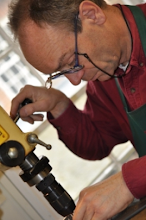My client hadn't had his longcase clock
serviced for a long while. "It begins to make funny sounds and the
striking is not consistent", he told me. My client lives in a house full
of golden retrievers. Alas, the case is not placed on a separate stand to avoid the
dogs' claws or the hoover kicking it. The clock had a calendar function (a
calendar disc), but it did not work. My fingers were
itching. I quoted my going rate for two weeks work.
 |
| the calendar disc after resilvering |
Looking at the break-arch shape of the
hood and engraved silver dial, the name and place of the maker, I estimated the
clock to be from about 1795. Every client I meet for the first time gets my
sermon about trying to conserve the clock for future generations. "You
may be the legal owner of this object but historically you will be judged as
its guardian. Why do you service your car every ten thousand miles while it
ends on the scrapheap during your life time, but you do not service your clock?
A dog may be for life, but a clock is for generations." Ultimately, if the guardian is doing his
job, the clock should end up in a museum.
When I examined
the clock back at my workbench I noticed that the intermediate calendar wheel—and
thus also its flag—and the stud that the intermediate calendar wheel is sitting
on were all missing. Why were they taken out? Clear hints indicated they had
been there before: the calendar wheel on the hour wheel between hour wheel and
snail, a hole in the front plate for the stud and the calendar disc was still
present, although turning black in several places!
So, I got the
intermediate calendar wheel from my usual supplier. I made the stud and the
flag. When I began testing the calendar disc, I noticed that the numbers 1
through 19 appeared beautifully centred in the dial’s calendar aperture.
However, the numbers 20 through 31 appeared too much to the right. I could
therefore not blame the flag for this error. I only saw one solution which I
did not like much from a conservation point of view: filing away little bits of
the relevant calendar disc’s teeth so that the numbers 20 through 31 would
appear centred in the aperture.
I enthusiastically started filing away in a
trial and error process. File a bit away. Check if the numbers appear more
centred. On some numbers this worked well. On others it did not. Without
thinking, I started filing away some more so that the numbers that did not
respond to the initial filing would now start responding. File and test, file
and test. After about three such rounds of filing and testing, some numbers
still did not respond as expected. Without stopping to think first, I resorted
to a somewhat rougher file in order to save time. File and test, file and
test.
Then (thank God) I
decided that just for 100% certainty, I should test the position of all numbers
(1 through 31) again. It was only then that I noticed that the numbers 1 and 2
were now no longer appearing in the centre of the aperture but were hanging to
the left, all other numbers were nicely in the centre while the numbers 20, 21
were still too far to the right. This finally got me to realise I had done
something stupid. I had been assuming all along that the flag was pushing the
calendar disc forward always at the tooth that is one day before the proper
date that appears in the aperture. Further examination showed that the flag
pushes the tooth that is three days before the proper date. Hence I had been
filing away the wrong teeth and thus committed a major conservation sin! The preacher caught out in an act of desecration!
I then
soldered on tiny bits of metal onto the two abused teeth so that 1 and 2 appear in the middle again and I filed down the correct teeth so that 20
and 21 now show nicely in the middle as well.
“Think before you
act” came to mind.
